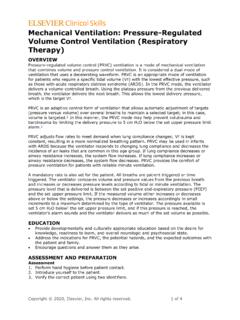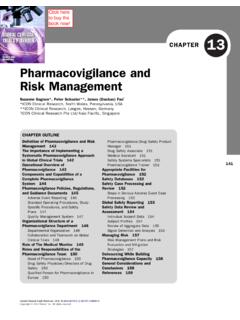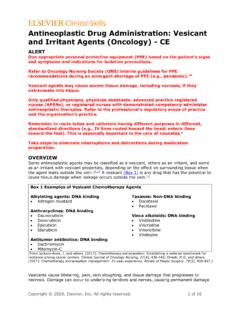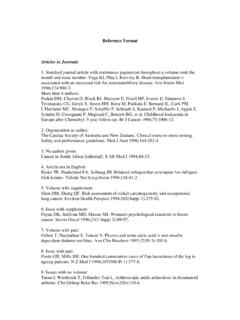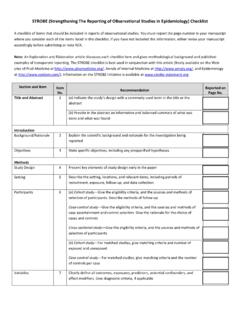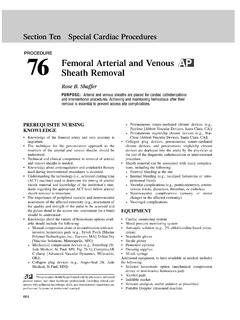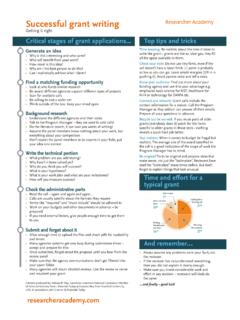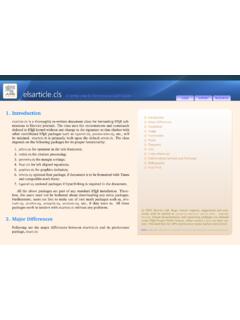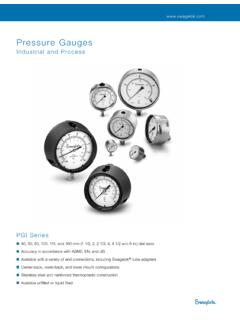Transcription of Mechanical Ventilation: Troubleshooting (Respiratory Therapy)
1 Mechanical Ventilation: Troubleshooting (Respiratory Therapy). ALERT. If the cause of an alarm cannot be identified and corrected quickly, remove the patient from the ventilator and begin manual ventilation with a manual resuscitation bag (MRB). To maintain patient safety, never disable alarms. OVERVIEW. Mechanical ventilator alarms are used to warn of changes in a patient's status. All alarms should be set according to the patient's condition and per the organization's practice. For patient safety, alarms should never be disabled. Some essential alarms on the ventilator include ventilator inoperative (vent INOP), power failure, no gas delivery to the patient, low peak inspiratory pressure (PIP), low tidal volume (VT), low or high minute volume (MV), low positive end-expiratory pressure and continuous positive airway pressure (PEEP/CPAP), apnea, inspiratory:expiratory (I:E) ratio, high- pressure limit, high respiratory rate, and low or high fraction of inspired oxygen (FIO2).
2 EDUCATION. Explain the meanings of the alarms to the patient and family. Explain the corrective measures needed or taken to address alarms as soon as possible. Assure the patient and family that staff members do respond appropriately to all alarms. ASSESSMENT AND PREPARATION. Assessment 1. Perform hand hygiene before patient contact. 2. Introduce yourself to the patient. 3. Verify the correct patient using two identifiers. 4. When an alarm sounds, quickly assess the patient's vital signs, including heart rate, respiratory rate, breath sounds, and peripheral oxygen saturation (SpO2). Preparation 1. Conduct a performance evaluation, or bench test, before patient connection. 1. 2. Ensure that a self-inflating resuscitation bag with an appropriate-size face mask is available, functional, and attached to a supplemental oxygen source. Attach a PEEP. valve, if necessary.
3 PROCEDURE. Ventilator Inoperative (Vent INOP). 1. Perform hand hygiene and don gloves. 2. Explain the procedure to the patient. 3. Immediately remove the patient from the ventilator and begin manual ventilation with an MRB. 4. Turn the ventilator off and restart 5. Follow the message instructions on the ventilator, if available. 6. If the ventilator fails to operate properly, tag it for a maintenance check and replace it with another ventilator. 7. Ensure that the alarms are set properly. Copyright 2020, Elsevier, Inc. All rights reserved. 1 of 8. Mechanical Ventilation: Troubleshooting (Respiratory Therapy). 8. Verify that the alarm has been corrected and the patient is stable. 9. Remove gloves and perform hand hygiene. 10. Document the procedure in the patient's record. Power Failure 1. Perform hand hygiene and don gloves. 2. Explain the procedure to the patient.
4 3. If the reason for the power failure cannot be identified, begin manual ventilation with a self-inflating resuscitation bag and replace the ventilator. 4. Assess the ventilator to make sure its power cord is plugged into an electric outlet that is connected to an emergency power source, such as a 5. If the external or internal battery is low, reconnect the ventilator's power cord to an electric outlet. 6. If applicable, check the fuse or circuit breaker by replacing the fuse or pressing the reset button next to the circuit breaker. 7. Ensure that the alarms are set properly. 8. Verify that the alarm has been corrected and the patient is stable. 9. Remove gloves and perform hand hygiene. 10. Document the procedure in the patient's record. No Gas Delivery to the Patient 1. Perform hand hygiene and don gloves. 2. Explain the procedure to the patient. 3. If the reason for the failure of gas delivery to the patient cannot be identified, begin manual ventilation with a self-inflating resuscitation bag and replace the 4.
5 Ensure that all high- pressure gas hoses are tightly connected to the appropriate gas sources. 5. Check oxygen and air pressure . a. The gas pressure gauge is located at the gas shut-off valve for the unit. b. Check the cylinder tank gauges if using freestanding gas cylinders. 6. Ensure that the alarms are set properly. 7. Verify that the alarm has been corrected and the patient is stable. 8. Remove gloves and perform hand hygiene. 9. Document the procedure in the patient's record. Low Peak Inspiratory pressure (PIP)2. 1. Perform hand hygiene and don gloves. 2. Verify the correct patient using two identifiers, if time permits. 3. Explain the procedure to the patient. 4. Check the circuit for leaks or disconnections. Tighten or reconnect the connections. 5. Check the patient's artificial airway cuff for leaks or deflation. 6. Check the humidifier for leaks or disconnections and tighten or reconnect the connections.
6 7. Check the inline suction system for leaks or disconnections. Tighten or reconnect the connections. Replace the inline suction system if a leak persists. Copyright 2020, Elsevier, Inc. All rights reserved. 2 of 8. Mechanical Ventilation: Troubleshooting (Respiratory Therapy). 8. Check inline adapters for a metered-dose inhaler (MDI) or a small volume nebulizer (SVN). Check them for leaks or disconnections and tighten or reconnect the adapter connections. 9. Check for chest tube leaks. If one is found, consult the practitioner for further interventions. 10. Ensure that the proximal pressure line is connected and unobstructed. 11. Ensure that alarms are set properly. 12. Verify that the alarm has been corrected and the patient is stable. 13. Remove gloves and perform hand hygiene. 14. Document the procedure in the patient's record. Low Tidal Volume (VT)2. 1. Perform hand hygiene and don gloves.
7 2. Verify the correct patient using two identifiers, if time permits. 3. Explain the procedure to the patient. 4. Check the circuit for leaks or disconnections. Tighten or reconnect the connections. 5. Check the artificial airway cuff for leaks or deflation. a. Check cuff pressure and listen for an air leak in the patient's trachea. b. Identify and correct the cause of the leak. 6. Check the humidifier for leaks or disconnections and tighten or reconnect the connections. 7. Check the inline suction system for leaks or disconnections. Tighten or reconnect the connections. Replace the inline suction system if a leak persists. 8. Check inline adapters for an MDI or an SVN. Check them for leaks or disconnections and tighten or reconnect the adapter connections. 9. Check for chest tube leaks. If one is found, consult the practitioner for further interventions. 10. Ensure that alarms are set properly.
8 11. Verify that the alarm has been corrected and the patient is stable. 12. Remove gloves and perform hand hygiene. 13. Document the procedure in the patient's record. Low Minute Volume (MV)2. 1. Perform hand hygiene and don gloves. 2. Verify the correct patient using two identifiers, if time permits. 3. Explain the procedure to the patient. 4. Assess the patient's respiratory rate and clinical condition for apnea, low respiratory rate, or low exhaled VT. a. If necessary, contact the practitioner and correct the clinical problem. b. Begin manual ventilation with an MRB if the patient is apneic. 5. Check the circuit for leaks or disconnections. Tighten or reconnect the connections. 6. Check the patient's artificial airway cuff for leaks or deflation. a. Check cuff pressure and listen for an air leak in the patient's trachea. b. Identify and correct the cause of the leak.
9 Copyright 2020, Elsevier, Inc. All rights reserved. 3 of 8. Mechanical Ventilation: Troubleshooting (Respiratory Therapy). 7. Check the humidifier for leaks or disconnections and tighten or reconnect the connections. 8. Check the inline suction system for leaks or disconnections. Tighten or reconnect the connections. Replace the inline suction system if a leak persists. 9. Check inline adapters for an MDI or an SVN. Check them for leaks or disconnections and tighten or reconnect the adapter connections. 10. Check for chest tube leaks. If one is found, consult the practitioner for further interventions. 11. Ensure that alarms are set properly. 12. Verify that the alarm has been corrected and the patient is stable. 13. Remove gloves and perform hand hygiene. 14. Document the procedure in the patient's record. Low Positive End-Expiratory pressure /Continuous Positive Airway pressure (PEEP/CPAP)2.
10 1. Perform hand hygiene and don gloves. 2. Verify the correct patient using two identifiers, if time permits. 3. Explain the procedure to the patient. 4. Check the circuit for leaks or disconnections. Tighten or reconnect the connections. 5. Check the patient's artificial airway cuff for leaks or deflation. a. Check cuff pressure and listen for an air leak in the patient's trachea. b. Identify and correct the cause of the leak. 6. Check the humidifier for leaks or disconnections and tighten or reconnect the connections. 7. Check the inline suction system for leaks or disconnections. Tighten or reconnect the connections. Replace the inline suction system if a leak persists. 8. Check inline adapters for an MDI or an SVN. Check them for leaks or disconnections and tighten or reconnect the adapter connections. 9. Check for chest tube leaks. If one is found, consult the practitioner for further interventions.
